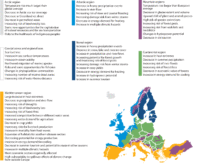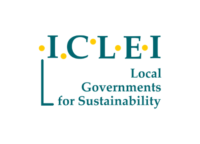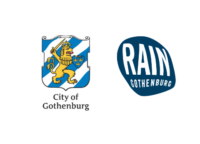Climate change is already having wide-reaching effects across the world. This page details some of the impacts for Europe and the countries participating in the Cultural Adaptations project, as well as some quality sources of information and research.
Europe is changing
Greenhouse gases we create and emit into our atmosphere are causing changes to our physical environment, which will also change our society, our economy and our culture. Our knowledge of climate change is not new, but growing media, political and social engagement has widened awareness of the causes and the impacts this will have for our lives. How we live, how we work, how we eat and how we travel has a significant effect on our environment: changing the delicate composition of our atmosphere, and depleting natural resources on the Earth’s land and seas.
The Evidence Base for Climate Change A brief history of climate changeMitigating and adapting
Although it may be possible to limit the extent to which our climate will change, we need to prepare for unavoidable, irreversible change.
Reducing greenhouse gas emissions (often called ‘carbon emissions’ as carbon dioxide is the most prevalent of the gases) is one of the ways we can respond to climate change. Becoming more energy and resource efficient, moving from a fossil fuel-based economy to one powered by renewable resources and increasing emissions ‘sinks’ (e.g. through restoring peat bogs), are all forms of mitigation. These efforts may reduce the intensity of future changes, but due to historic emissions since the Industrial Revolution, some climatic changes are certain to occur. Adaptation initiatives therefore explore adjusting to actual or projected future climates, anticipating making changes to our society, economic or surrounding environment to cope with this new future.
The difference between adaptation and mitigation Climate Action Tracker: are we on track with national mitigation efforts?Different impacts in different places at different times
Climate change will affect people and places in different ways, and at different rates of change.
Although humans and our physical environment have been able to adapt to changes in our climate in the past, the pace of these current and coming changes is much faster than we have experienced in our history, making it more difficult and complex than ever before. There will be negative impacts, but there are also likely to be positive opportunities stemming from these changes which could improve health, well-being and our physical environment.
While climate change is happening on a global scale, the effects vary at a regional and local level. This image from the European Environment Agency demonstrates the generalised expected impacts across Europe:

Expected climate impacts
The international science community has undertaken lots of modelling to understand how our climate is likely to change in the coming years, and has found evidence of changes already taking place.
Across Europe, there are expected to be a large range of consequences: from increasing heat and unseasonal weather changing behaviours, to changing rainfall patterns affecting water availability and quality. Different types of environments experience these changes differently, and some areas are more vulnerable than others. Aross Europe, the most vulnerable geographic areas are:
- Coastal environments: melting polar ice sheets and glaciers increase sea levels, flooding low-lying land and affecting animal, plant and human life.
- Alpine, upland and Arctic environments: increased heat increases the extent of glacier and permafrost spring melting. Already delicate environments, this has far-reaching consequences for biodiversity.
- Urban environments: concrete-dominated cities absorb increased heat, with significant health implications.
- South and south-eastern environments: reduced rainfall leads to drought and increased instance of wildfire.
Those living in Europe are also vulnerable to climate change impacts being felt across the world. In our increasingly globalised world, impacts being experienced on other continents can create risks to food supply, increase the volatility of resource prices and change migration patterns.
In north-western Europe
The Cultural Adaptations project is a partnership between organisations in Belgium, Ireland, Scotland and Sweden. Although distinct in many ways, each country is at least partly coastal (either bordering the North Sea or Atlantic Ocean), and is based in the north-western part of Europe.
Trends for north-west Europe are typified by the expectation of ‘warmer, wetter and wilder weather’, and climatic trends can be summarised as:
- Increased summer temperatures leading to heatwaves and increased instances of pests (ticks; mosquitoes), but also increased opportunity for summer tourism.
- Increased winter temperatures, reducing snowfall and ice cover, but also reducing winter heating needs.
- Increased precipitation (rain, hail), creating flash flooding, but also increasing opportunities for hydro-power.
- Some sea level rise affecting low lying land, often harbours or coastal resorts.
- Increased instances of extreme weather events and storms, causing damage and disruption.
In city regions
80% of the European population expected to live in urban areas by 2050. Cities and their surrounding regions are the places where most people make their homes, participate in work and socialise. Although climate change is taking place on a global scale, the realities of the changes are best understood and recognised at a regional level.
Cultural Adaptations therefore concentrates on one particular city region in each of our partner countries. Each city region has an industrial history, a historic centre, a major waterway and some shared anticipated impacts of climate change, but each also have their own unique topography, socio-economic context and approach to climate change adaptation.
More information about the knowledge around how climate change will affect these four cities, and the current approach to tackling the challenges and opportunities these changes will bring, can be found in the documents below:
Further resources on climate change and impacts for Europe
There are lots of high-quality sources of information about the causes of climate change, the expected impacts for different geographic regions, the responses of various national governments, and how likely different projections are. The various links below will take you to websites, guides and tools to add to the information outlined above.
Do you have a recommendation of a website, report, video or podcast which you have found helpful in understanding this topic? Let us know! This resource is collaborative and evolving, and we value your input.















